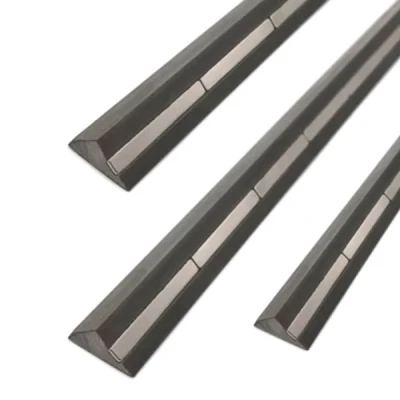In today’s precast concrete industry, magnetic chamfers are indispensable for achieving precise panel edges and a clean finish. But when it comes to choosing between triangular and trapezoidal chamfers, which is the better fit? Each has unique strengths in terms of accuracy, stability, and application range. Triangular chamfers excel in tight or decorative corners, while trapezoidal options provide superior support for large-scale panels. This article explores both types, compares their features, and guides you toward the best choice for your production needs.
What Are Magnetic Chamfers?
Magnetic chamfers are precast accessories equipped with strong magnets that hold formwork edges securely during casting. Their main purpose is to shape corners consistently, prevent misalignment, and reduce manual labor. By eliminating clamps and supports, they shorten setup time and streamline the overall process.

Materials and Magnetic Power
- Materials: Typically made from durable metals or high-strength composites that withstand repeated use.
- Magnet Type: Neodymium magnets provide superior holding force, while ferrite magnets offer a more cost-friendly solution.
Triangular Magnetic Chamfers
Triangular chamfers are known for their precision and versatility, particularly in complex designs or panels with sharp corners.
Best Applications:
- Narrow or intricate corners
- Decorative or visible panels
- Complex, small-to-medium designs
Advantages:
- Creates sharp, consistent edges
- Easy to install and reposition
- Cost-effective for small-scale projects
- Works with both manual and automated systems
Limitations:
- Limited stability for long or wide panels
- May need reinforcement in high-stress or vibration-prone applications
- Less efficient for large-scale automated production
Trapezoidal Magnetic Chamfers
With their broader base, trapezoidal chamfers are engineered for stability in large panels and demanding production lines.
Best Applications:
- Long or wide panels
- Edges requiring strong stability
- Automated production systems
Advantages:
- Strong edge stability throughout casting
- Minimizes panel movement and misalignment
- Compatible with automation and heavy-duty workflows
- Produces straight, uniform finishes on large exposed surfaces
Limitations:
- Higher cost due to larger size and material use
- Bulkier and heavier, making handling more difficult
- Less suitable for sharp or intricate corners
Comparison: Triangle vs. Trapezoid
| Feature | Triangle Chamfer | Trapezoid Chamfer |
|---|---|---|
| Best Use | Small, detailed panels | Large, heavy panels |
| Precision | Excellent in corners | Reliable on long edges |
| Stability | Medium | High |
| Magnetic Strength | Moderate | Strong |
| Ease of Handling | Lightweight & easy | Heavier, moderate effort |
| Cost | Lower | Higher |
| Limitations | Weak on long edges | Not ideal for tight corners |
Choosing the Right Chamfer
The right chamfer depends on your project’s scale and design:
- For sharp corners or complex patterns: Choose a triangular chamfer.
- For wide panels and long edges: Opt for a trapezoidal chamfer.
- For manual setups, Triangular chamfers are often more practical.
- For automated systems: Trapezoidal chamfers provide stability and consistency.
Final Thoughts
Magnetic chamfers are essential for producing high-quality precast concrete panels with precision and efficiency. Triangular chamfers bring accuracy and cost savings to smaller, intricate projects, while trapezoidal chamfers deliver stability and reliability for large-scale production. By understanding their strengths and limitations, precast manufacturers can choose the most suitable solution, optimize workflows, and achieve superior results with fewer errors and reduced labor.

